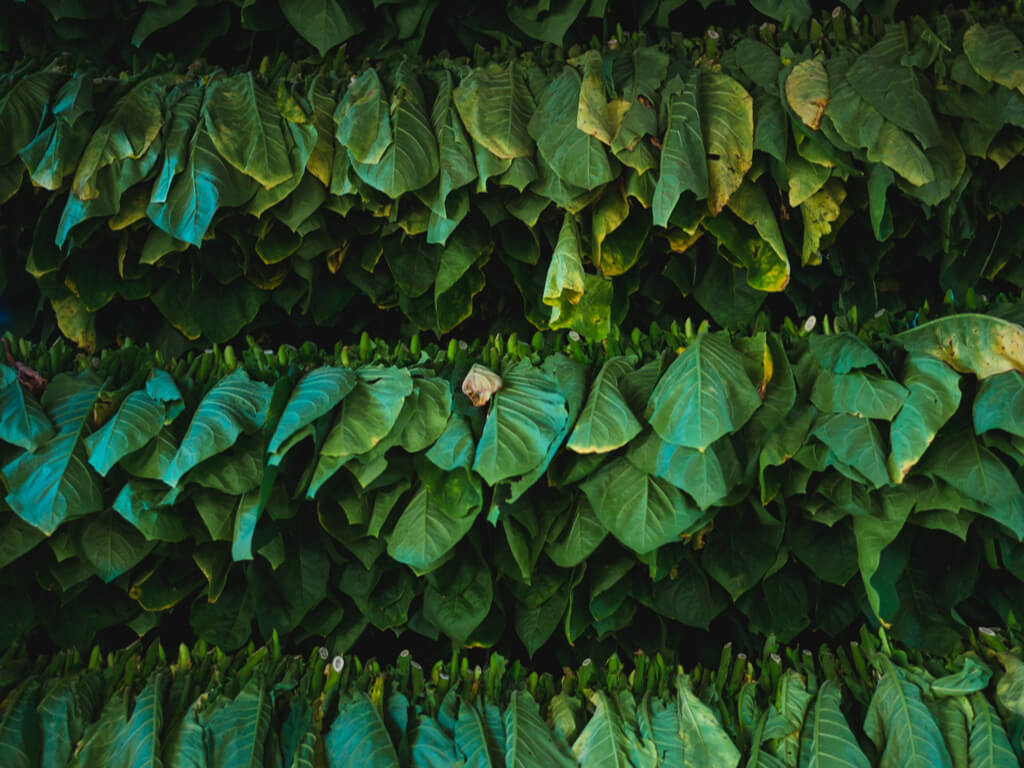Snus production
Manufacturing snus
In order to create a high-quality snus, it is necessary that the raw material is of a top quality. Many brands collaborate with cultivators in around the world so they can ensure their purchases meet an end result of specific standards. The list of requirements might include specific tobacco varieties, drying methods, product analyses that show approved values for unwanted substances such as pesticides. It can also be demands on social aspects such as working conditions on farms including fair trade requirements.
There are a number of different grades that can be found in raw tobacco. First, it is sorted according country/region, its variety and which part of the plant – leaf or stalk.
A premium snus might contain twenty to twenty-five different grades of tobacco. The ideal dried leaf used for snusproduction is approximately 30 cm long, and dark brown in color. It should be firm with a slightly sticky surface. If you bite properly this product should offer fresh flavors without any bitterness at all.
Countries where tobacco is grown
The tobacco plant is a crop that can be cultivated almost anywhere in the world. The best raw tobacco comes from areas with mild, sunny climates and has been grown for centuries for diffrent purposes. Tobacco is grown in 120 countries but the largest producing countries is China, Brazil, India, and the US and grows two thirds of all global output.
The most popular use of tobacco today is in cigarettes, but it is also used in cigars, pipe tobacco, and various smokeless tobacco products. Swedish snus manufacturers buy tobacco from several countries in order to acquire different styles of tobacco for their mixtures.
The tobacco plant
The tobacco plant is a part of the Solanaceae family, which also includes the potato and tomato. There are primarily two species of the plant, Nicotiana abacom and Nicoriana rustica, that are cultivated for tobacco.
Nicotiana tabacum – is a elegant, shifting and allaround plant.
Nicotania rustica – is a simple, rustic and high on nicotine.
As the tobacco plant grows, it divides into two parts: the lamina and the stalk. The lamina is made up of the leaves, which have a higher concentration of nicotine than the stalk. The concentration of nicotine rises as you move up the leaf, towards the pointy end. These differences in the leaves lead to a variety of different flavors and nicotine levels. It is important for snus makers, they want the leaves at midstalk, because they have the most even distribution of nicotine and aromas.
While tobacco plants contain natural sugars, these are reduced during the drying process. The aromas that result from this transformation provide a crucial component to snus flavor and aroma profile.
Drying
Drying tobacco can be done in four different ways. Air-dried is the primary method for Swedish snus, but there’s also sun dried.
Air cured – The tobacco is hung in well-ventilated barns to dry for at least four weeks, protected from rain and sun. This slow process reduces chlorophyll content while increasing nicotine levels which make it into an effective crop used by many people around the world.
Sun cured – The flavor from this method is more intense than it would be if air cured. The leaves are dried under a sunny sky, which helps to produce an intensely flavored product with lower sugar levels and higher concentrations for nicotine.
Flue cured – With this system, tobacco plants are heated and then blown with temperature-regulating air. This method is quick and has good control because there’s only one temperature for all plants in an area. It also requires an expensive setup costs to get everything going smoothly.
Fire cured – This method of making tobacco requires the use hardwoods like oak or hickory. The fire is made with smoldering coals and it can take anywhere from a few days to weeks for this process, but once finished the tobacco will have some seriously fine smoke flavor.
The dried tobacco is now ready for shipment. It has been cleaned, conditioned and prepared so that it can be milled into fine by the snus manufactures.
At the factory
Today’s snus manufacturing plants are like modern food-processing plants. They take tobacco, water and additives like salt, sodium, carbonate, glycerin and flavourings.
Milling – Dried tobacco leaves are ground into one of three milling grades: fine, medium or coarse. The different types affect the consistency and flavor profile as well as nicotine release. Fine snus has a firmer texture and is easier to bake, while coarse snus has a stronger aroma and taste.
Mixing – The milled tobacco is mixed. In modern snus production, this takes place in special mixing silos. A mixture might contain up to twenty to twenty-five grades of tobacco. Water and salt are added. This mixing phase is extremely important along with milling grade and flavoring. It is the foundation of a brand’s style.
Sweating – The mixture is heated in a process similar to pasteurization. It kills harmful bacteria and microorganisms and prolongs the product’s shelf life. It also gives the tobacco a fuller and more mature aroma and taste. The mixture is immediately chilled after the sweating is done.
Additives – Sodium carbonate, which converts to bicarbonate of soda and brings the pH upward, is necessary to release nicotine. Then glycerin, which preserves moisture is added. Aromas are then mixed in, which infuse the snus with its final taste. The snus will now go through its final mix and then ready for packaging and stored in refrigerator until shipped to consumers.
Cut snus
There has been a trend of snus being cut instead of milled, which we notice more and more with some Swedish brands. The leaves are steamed on beds before they’re put through knives-cutting processes that is a gentler method than milling. The tobacco is then dried. Cut snus ages more slowly than milled snus. It preserves its resilience, texture, and nicotine level longer.
Nicotine levels
The level of nicotine in snus varies depending on the tobacco types, which differ significantly with regard to their content. There’s also a variety when it comes down choosing leaves; some are placed higher up towards where they’ll grow vs lower-lying growth areas.
Snus nicotine levels vary from standard levels of about 0.8 percent, commonly found in snus labeled “Original,” up to stronger varieties containing 1.2 to 1.5 percent, and all the way up to Extra strong or Super strong snus with 2.0 percent nicotine.
Svea Tobacco’s scale for nicotine levels:
| Strength | Levels | Example |
| Normal | 7,5 – 10 mg/g | Ettan Portion |
| Strong | 11 – 15 mg/g | Nick & Johnny Red Hot |
| Extra Strong | 16 – 20 mg/g | Granit Strong White |
| Super Strong | 21 – 43 mg/g | Siberia 80 White Dry |
Aromatics and additives
The base of Swedish snus is a carefully selected tobacco mixture. Then added water and also salt and other pH-regulating substances as well. To give this final product its signature taste characteristics, aroma ingredients are added to create an even more flavorful experience.
For a long time Swedish snus has had only a few aromatics. One was bergamot and also citrus and tea. Today you can find a whole other flavor palete. Some popular ones is licorice, junipers and mint. The new flavors are constantly coming out, but it can be hard to find one that fits your taste. Sometimes they overpower the tobacco characteristics or just feel out of place.
We try to describe the taste, drip and nicotine realese in our product-descriptions. We also list taste and nicotine levels in properties under every product so you as a customer can get a picture of the product. If you wonder something about taste, nicotine levels or anything else you are welcome to reach out to us, and we will try to answer.

